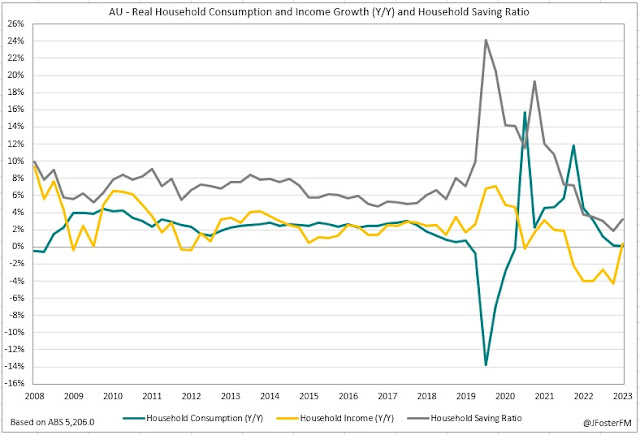The December quarter National Accounts confirmed that momentum in the Australian economy slowed materially in 2023. Real GDP printed at 0.2% in Q4 (vs 0.2% expected, 0.3% prior) as year-ended growth eased from 2.1% to 1.5%. With the recovery from the pandemic having run its course, household consumption in 2023 became increasingly exposed to the headwinds of higher interest rates and cost-of-living pressures. As this played out, GDP growth slowed from 1% in the first half of the year to 0.5% through the back half, its softest half-year outturn outside of the Covid period since 2008 following the financial crisis. Alongside this, inflation slowed notably into year-end and labour market tightness also eased. The RBA's assessment of the economy operating in excess demand was already contentious and looks even harder to sustain now.
Over the past year, public demand has been the major driver of growth - as governments have boosted cost-of-living support and progress on infrastructure works have ramped up - helping to offset slowing private demand. This was also the case in Q4: domestic demand (0.1%) was held up by a 0.4% lift in public demand as private demand stalled (0%). Net exports added to growth (0.6ppt) while inventories weighed (-0.3ppt).
Private demand remained supported by business investment (0.7%q/q), which has risen strongly over the year (8.3%) on a delayed rebound from the pandemic, but has been weighed by weakness in household consumption (0.1%q/q, 0.1%Y/Y) and dwelling investment (-3.8%q/q, 3.1%Y/Y).
Household consumption has effectively stalled. Over the past year, pressures on finances through higher mortgage payments, increased income tax alongside rising wages and the rise in the cost of living prompted households to wind back discretionary consumption (-1.6%) and prioritise essentials (1.2%).
There were tentative signs, however, that suggest the outlook for consumption could improve. With inflation slowing sharply in Q4 and following an earlier acceleration in wages growth, real disposable income growth turned positive (albeit very slightly) in annual terms (0.3%) for the first time since mid-2022. Over this period of negative real income growth, savings accumulated during the pandemic have been drawn down to support consumption and this could continue into 2024. Also helping is that the government's Stage 3 tax cuts will come into effect from the middle of the year, while weakness in the data has firmed expectations for 1-2 RBA rate cuts this year. Furthermore, the improved dynamics around real incomes halted the slide in the household saving ratio; however, at 3.2%, it remains well short of returning to pre-Covid levels (5-6%). A faster or more substantial weakening in the labour market is the obvious risk to this optimism.





